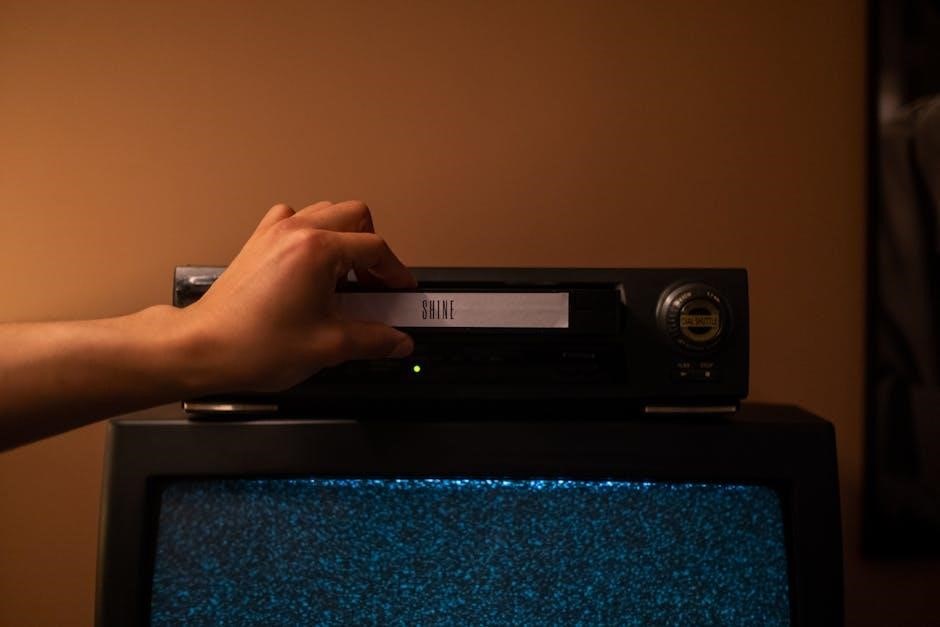Overview of the Honeywell RTH221B Thermostat
The Honeywell RTH221B is a 1-week programmable thermostat offering precise temperature control with a PI algorithm and one-touch overrides․ It runs on 2 AAA batteries․
1․1 Key Features of the RTH221B
The Honeywell RTH221B features a 1-week programmable schedule, allowing users to set specific temperatures for different days․ It includes a PI algorithm for precise temperature control, ensuring consistent comfort․ The thermostat offers one-touch temperature override, enabling quick manual adjustments without altering the programmed schedule․ It operates on 2 AAA batteries, eliminating the need for hardwiring․ Additionally, it supports systems with 24 volts or 750 mV, making it versatile for various HVAC setups․ Its user-friendly interface and compact design make it an ideal choice for homeowners seeking reliable and efficient temperature management․
1․2 Compatibility and System Requirements
The Honeywell RTH221B is compatible with 24-volt and 750 mV HVAC systems․ It does not support heat pumps with backup heat or multistage systems․ The thermostat requires 2 AAA batteries for operation․ Ensure your system meets these specifications before installation to guarantee optimal performance and avoid compatibility issues․ Proper system matching is crucial for efficient temperature control and to prevent potential operational problems․ Always verify system type and voltage requirements prior to installation to ensure smooth functionality․ This thermostat is designed for single-stage heating and cooling systems only․
Installation and Setup
Drill holes at marked positions, insert supplied anchors, and level the thermostat for proper installation․ Match your system type during setup for optimal performance and functionality․
2․1 System Compatibility Check
Ensure the Honeywell RTH221B is compatible with your HVAC system․ It operates on 24-volt or 750mV systems but does not support heat pumps with backup heat or multistage systems․ Verify your system type, voltage, and stage compatibility before installation to avoid issues․ Check the user manual for specific requirements and ensure your system matches the thermostat’s specifications for proper functionality and safe operation․ If unsure, consult a professional to confirm compatibility and proceed with installation․
2;2 Physical Installation Steps

Begin by turning off the power to your HVAC system at the circuit breaker․ Remove the old thermostat and take note of the wire connections․ Mark the wall where the new thermostat will be installed, ensuring it is level for proper function․ Drill holes at the marked positions and insert the supplied wall anchors․ Mount the thermostat base, connecting the wires according to the manual’s wiring diagram․ Secure the wires tightly and attach the thermostat faceplate․ Turn the power back on and test the system․ If unsure, refer to the manual or seek professional assistance for accurate installation․
Programming the Thermostat
Program the Honeywell RTH221B by setting a 7-day schedule with specific temperatures for different times․ Use temporary or permanent overrides as needed for flexibility․

3․1 Creating a Weekly Schedule
To create a weekly schedule on the Honeywell RTH221B, go to the menu and select “Schedule․” Choose the day(s) you want to program and set the desired temperature for different time periods․ You can set up to four different temperature settings per day․ Save your changes to apply the schedule․ The thermostat allows flexibility by enabling temporary overrides without affecting the permanent schedule․
3․2 Temporary and Permanent Overrides
The Honeywell RTH221B allows users to override the programmed schedule temporarily or permanently․ Temporary overrides let you adjust the temperature without changing the set schedule, reverting after the current period․ Permanent overrides disable the schedule, maintaining the desired temperature continuously․ To activate a temporary override, press the touchscreen and adjust the temperature․ For permanent overrides, navigate to the menu, select ” permanent hold,” and confirm․ This feature ensures flexibility for unexpected changes in your routine․ Refer to the manual for detailed steps on managing overrides effectively․


Advanced Features
The RTH221B features a PI algorithm for precise temperature control and one-touch overrides for easy adjustments, enhancing comfort and efficiency in temperature management․
4․1 One-Touch Temperature Control
The One-Touch feature allows users to override the programmed schedule temporarily, enabling manual temperature adjustments without altering the set program․ This is ideal for unexpected changes in occupancy or comfort needs․ The override remains active until the next scheduled temperature change, ensuring seamless transitions while maintaining energy efficiency․ This feature is accessed directly from the thermostat’s interface, providing quick and intuitive control․ It enhances flexibility, making the RTH221B adaptable to varying household routines and preferences․ The simplicity of this function ensures ease of use for all users․
4․2 PI Algorithm for Precise Temperature Management
The Honeywell RTH221B incorporates a PI (Proportional-Integral) algorithm to ensure precise temperature control․ This advanced feature continuously monitors and adjusts heating or cooling outputs to maintain the set temperature, minimizing fluctuations․ The PI algorithm optimizes performance by learning the system’s response, providing consistent comfort while reducing energy usage․ It works seamlessly with the thermostat’s scheduling and override functions, ensuring accurate temperature management․ This feature is particularly effective in maintaining a stable indoor climate, making it ideal for homeowners seeking reliable and efficient temperature control solutions․

Power and Battery Management
The Honeywell RTH221B operates on 2 AAA batteries, ensuring reliable performance without hardwiring․ It features low-battery indicators for timely replacements, maintaining consistent temperature control․
5․1 Battery Requirements and Installation
The Honeywell RTH221B requires 2 AAA alkaline batteries for operation․ Ensure batteries are installed correctly, following the polarity indicators in the battery compartment․ Proper installation guarantees reliable performance․ The thermostat provides low-battery warnings, alerting you when replacements are needed․ Use high-quality batteries to maintain consistent functionality․ Avoid mixing old and new batteries to prevent power issues․ Replace batteries promptly to avoid system downtime․ Always turn off the thermostat before battery replacement to ensure smooth operation․ Proper battery management extends the product’s lifespan and ensures accurate temperature control․ Refer to the manual for detailed steps․
5․2 Low Battery Indications and Solutions
The RTH221B displays a low-battery warning when power levels drop․ This is indicated by a flashing battery icon or a message on the screen․ Immediate action is required to maintain functionality․ Replace the batteries with new AAA alkaline ones, ensuring correct polarity․ If the thermostat shuts down, remove the old batteries and install new ones promptly․ Reset the thermostat after replacement to restore normal operation․ Ignoring the low-battery alert may cause temperature control issues or system shutdown․ Always keep spare batteries handy to avoid interruptions in heating or cooling․
Troubleshooting Common Issues
The RTH221B may face issues like unresponsiveness or incorrect temperature readings․ Check for loose wires, dead batteries, or incorrect settings․ Resetting often resolves these problems․
6․1 Common Errors and Solutions
Common issues with the RTH221B include unresponsiveness, incorrect temperatures, and display malfunctions․ Solutions involve checking battery levels, ensuring proper wiring, and verifying system compatibility․ Resetting the thermostat often resolves operational glitches․ For persistent problems, refer to the manual or contact support․ Regular updates and proper installation are key to maintaining functionality and avoiding errors․
6․2 Resetting the Thermostat
To reset the Honeywell RTH221B, remove the batteries and press the reset button located on the back of the thermostat․ Hold the button for 5 seconds, then release and reinstall the batteries․ This process restores factory settings, clearing schedules and overrides․ Ensure the thermostat is level during reinstallation for proper functionality․ Resetting is useful for resolving persistent issues or preparing for a new installation․ Always refer to the manual for detailed reset instructions specific to your model․
The Honeywell RTH221B offers a user-friendly, efficient solution for temperature control․ With features like one-touch overrides and a PI algorithm, it ensures precise management․ Battery-powered and compatible with various systems, it’s ideal for many households․ Proper installation, scheduling, and maintenance, as outlined in the manual, optimize performance․ Troubleshooting common issues and resetting when needed help maintain functionality․ Overall, the RTH221B is a reliable choice for those seeking a programmable thermostat with advanced yet easy-to-use controls, making it a valuable addition to any home․

